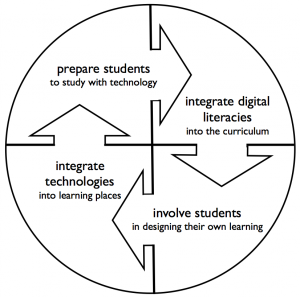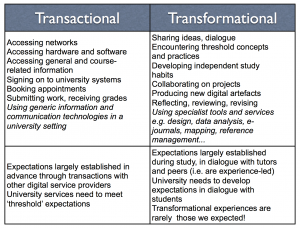The latest events in our consultation programme have thrown up a host of ideas, along with practical suggestions for how institutions can respond to the digital student agenda. I’ve already posted up the slides and outcomes from our whole-day event in London with AUDE, SCHOMS and UCISA members, and our morning session with HeLF members in Leeds. In this blog post I’ll try to make some sense of the issues that have been raised.
 Way back in 2001 I designed a TEL audit for institutions that encompassed three broad areas of culture, infrastructure and expertise. It seems to me that the responses identified as critical to the student digital experience still fall into these three areas. What has changed is the detail under each headline.
Way back in 2001 I designed a TEL audit for institutions that encompassed three broad areas of culture, infrastructure and expertise. It seems to me that the responses identified as critical to the student digital experience still fall into these three areas. What has changed is the detail under each headline.
So for example under ‘learning skills’ we have had detailed discussions about what induction and pre-induction need to look like in this new environment of mixed personal and institutional technologies. Students need a much clearer understanding, rooted in their subject area, of how digital technologies can support their learning and future career. They need to be reassured that their existing digital skills are assets, but that the academic context demands new standards of expression, new criteria for success, and new ways of behaving ethically around shared knowledge. They also need help to identify digital strengths and weaknesses and to get any support they require to step up to university study. Ideas for achieving this include pre-induction social spaces, partnerships with schools and colleges, involvement of student mentors, new academic tasks for the induction period, and sharing good practice across departments and courses. Benefits of this approach are that student expectations are actively managed, and students are less likely to be disappointed or frustrated by their digital experience. In this category we have also exchanged ideas about how students can support one anothers’ developing digital and academic practices, which links across to ‘student engagement’ generally.
Under ‘digital environment’ there are also new considerations, some of which I would characterise as a tension between ‘branding and blending‘. Professionals with responsibility for the digital environment have in recent years been focused on interoperability and integration, so that students benefit from single sign-on to academic services, and can access (for example) subscription services via google searches while they are on campus. Cloud solutions give students a more familiar environment for their day-to-day transactions and support a more seamless blend of personal, institutional and third-party services. But this frictionless transition from one service and online space to another is undermining students’ sense of what the university provides for their benefit. As with other key issues, the solutions cross areas of responsibility. So ‘branding’ university services means attending to interface design, but also to student digital awareness – so students understand online boundaries and know when they are accessing university facilities, with the associated benefits and rules. Approaches such as web-space for life, student dashboards and better branding of cloud services have been discussed as means of securing student affiliation with their institution.
Arguably, finding the right balance between ‘branding and blending’ applies to a range of considerations from design of study spaces to development of online courses. Spaces and places of learning continue to be critical to the student experience. Digital services can enrich those spaces, while keeping them closely identified in students’ minds with the institution at which they have chosen to study.
(By the way, I think the three-part model I have posted above is related to MacNeil and Johnston’s ‘digital university’ matrix and more specifically to the four habits of successful digital universities that we identified in the SLiDA project, 2011. See below.)
Finally, the idea that some uses of technology in university settings are ‘transactional‘ while others are ‘transformational‘ (an idea borrowed from leadership studies) has gained considerable recognition. Participants at the HeLF forum wrote on our googledoc:
Learning is hard, it takes hard work, lots of reading, the development of efficient ways of thinking. Any particular technology needs to support this [understanding] rather than dismantle it.
Good education is about empowerment, this is the true transformational change.
In thinking about students’ expectations and experiences it is important to get the basics right – access to devices, functional skills, robust wifi, secure and safe use of digital services. But the digital environment in a university setting needs to do more than this. It needs to support innovation in teaching methods and provide a space to play (and fail). It needs to gives students progressively more scope to express their ideas in public, create a public digital persona, and share knowledge in open communities. These make very particular demands on service providers and on the capabilities of students and staff. We continue to find inspiring examples of how this can work.



2 replies on “Branding vs blending, and other emerging issues”
[…] have explored the ‘branding and blending‘ issue in another post. Last week I presented two new formulae – though the ideas are […]
i attended the APT 2014 workshop which was really interesting , but would just like to add that I find the SAMR model proposed by Ruben Puentedura a fuller exposition of this general idea, and the need to have a ‘ paradigm shift’ (Anderson et al) in pedagogy for true ‘Technology Enhanced Learning’ here’s a link to an example : https://sites.google.com/a/msad60.org/technology-is-learning/samr-model
As has been clear for many years, this paradigm shift also requires investment in staff development.